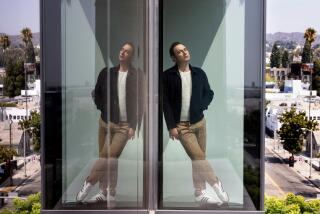S.D. Pioneers Job of Overseeing Esthetics
Skepticism is often the best response to “breakthroughs” dreamed up by politicians. But, in the case of San Diego’s newly appointed city architect, some of the drumbeating seems justified.
Two weeks ago, city planning director Robert Spaulding announced the appointment of Mike Stepner, former assistant planning director, to the new job originally proposed by Mayor Maureen O’Connor in her State of the City Address last January.
An informal survey of the seven U. S. cities larger than San Diego (as ranked by the 1988 “Information Please Almanac”) indicates none has a city architect as defined here. Many have architects on their staffs, but there is no single person whose entire job responsibility is to oversee the quality of a city’s architecture, from public works projects to urban design. The job is administrative. Stepner will not be doing actual design work.
“The way you’ve conceived the job down there, no one else has got it,” said William Fulton, who publishes a statewide newsletter on planning and development issues and contributes to Planning magazine.
“Stepner told me he’s not going to design any fire stations. In a way, he’s not a city architect, but sort of an urban design czar. I can’t think of another city where the job comes out of the planning department and sets the tone for all design in the community.”
Seeking Information
Does city architect sound like a blockbuster job?
“It sure does. Most cities have those responsibilities divided up,” Fulton said. “Urban design controls would be enforced by an urban design specialist in the planning department, for example, while historic preservation would be a separate commission.”
In San Diego, that has certainly been true. Did you want information on historic preservation? Hiring of architects for such city projects as fire stations and libraries? Urban design guidelines for El Cajon Boulevard? You might spend a frustrating half hour on the phone getting to the right person.
But you would not have been alone. The largest U. S. cities appear to be equally disorganized when it comes to architecture. None, including New York City and Los Angeles, have city architects, although all have architects on the staff in various capacities.
“The job sounds wonderful,” says Martha Ritter, director of public affairs in New York. The Big Apple has a “chief urban designer,” but responsibilities don’t include things like upgrading the quality of public projects and overseeing historical preservation.
Chicago has at least one staff architect. “I’m not sure the other is still with us,” a phone operator reported.
An operator in Houston was more perplexed. “Uh . . . hold on,” she said, putting the caller on hold while she sought out someone who could answer. Finally, a person identifying himself as “deputy director of design and construction” came on the line with the news that Houston does have a manager of architecture, but he is not very autonomous.
Token Architect
Mary Kay Noyallis in Philadelphia said, “I’m the token landscape architect, and we also have an architect on staff, but we are planners first.”
Dallas, the nation’s seventh largest city, has an equally fragmented system, with architects working in several departments, but no one person or department who takes overall responsibility for the city’s architecture.
So, on this score, San Diego is ahead of the rest of the country. O’Connor’s proposal for a city architect has resulted in something tangible and progressive that may make a genuine difference in the qualify of the city.
Most people in the architectural community agree that Stepner is the best man for the job, that he has the right mix of sensitivity to design, planning experience and calm ambassador’s demeanor.
Now, his task is to define the new city architect’s office as part of a major restructuring of the city’s planning department. Stepner, whose practical experience includes multifamily housing in Chicago and master planning there in conjunction with Skidmore Owings Merrill and C. F. Murphy, already has the makings of his basic team.
“There are three players who will be key,” Stepner said. “Larry Monserrate, who’s now in charge of downtown planning. Marcia Maleske, urban conservation and historic preservation. And Paul Curcio, urban design.”
Stepner will also be adding design experts from the city manager’s office with expertise in public improvements and landscape design specialists, among others.
Obvious Questions
Two obvious questions that arise with the radical restructuring have to do with the future of the city’s existing architectural selection committee for city projects, and possible changes in the Centre City Development Corp.’s role in regulating urban design downtown.
“The committee will still be selecting architects for city projects,” Stepner said. “In the past, we’ve done some award-winning projects, especially libraries. But we’ve done a lot which, in achieving their basic function--whether it’s housing fire trucks or an equipment yard--are blighting influences. In many cases, there have been complaints that the city’s process for reviewing its own buildings is not as demanding as the review we do of private projects.”
The lost opportunities in San Diego are many: a downtown waterfront already being walled off by high-rises, several of architect Irving Gill’s finest buildings demolished, a generation of high-rises built with little regard for the people who use them, a city hall that looks more like a high-rise prison.
Now, there’s a chance for something better. Architecture citywide is bound to improve with a competent city architect in place, someone who is accountable for both triumphs and failures.
DESIGN NOTES:
Architect Rob Quigley is busy. He’s designing a new Sherman Heights Community Center, and chairing the architectural review board for the UCSD campus. Chancellor Richard Atkinson even had Quigley’s board over for dinner. The architect acknowledges hoping for a position of some kind at UCSD’s new architecture school when it opens in the ‘90s. . . . “About Face,” an exhibit of graphic design work on display through the end of the month at ArtistSpace at SouthFair, 2010 Jimmy Durante Blvd., Del Mar. . . . In the new, 18,000-square-foot Sherle Wagner kitchen and bath showroom in the Morena design district not far from Price Club, a bathroom vignette by San Diego architect John Nalevanko includes a stunning cylindrical soaking tub wrapped in etched pewter.
More to Read
The biggest entertainment stories
Get our big stories about Hollywood, film, television, music, arts, culture and more right in your inbox as soon as they publish.
You may occasionally receive promotional content from the Los Angeles Times.










